Velázquez, Diego (1599-1660)
Felipe IV (Philip IV)
c.1653
Oil on canvas, 69.3 x 56.5 cm
Museo del Prado, Madrid
This image can be identified as that of a king and as a portrait of Philip IV on the basis of others of the monarch. In fact, nothing about the clothes or the sitter’s actions suggests his royal status except the easily recognisable physical features of the Habsburg dynasty, in particular the prominent chin. This portrait and the one who is in the National Gallery gave rise to a large number of versions and became the official image of Philip during the last part of his reign. Paradoxically, despite the King’s declared reluctance to seeing himself growing old, they have given rise to the largest group of portraits of him to have survived. In these works the Spanish court portrait regains some of the characteristics that defined it when Velázquez first arrived at court in 1623. Such works have a narrow chromatic range and an emphasis on blacks and greys, while all the elements in the composition function to focus the viewer’s attention on the face. Thirty years before, that sobriety had involved a political element, as it reflected the reformist intentions of the new monarch and his court. By the mid-1650s the King’s image had been stripped of earthly messages and had become sacralised; in fact the version in the Prado strongly suggests a vera effigies and indicates the extent to which the King’s face had become universally recognisable. Knowledge of the older Philip‘s face was not only disseminated through these paintings but also through prints based on them that illustrated a number of books in the 1650s and 1660s, many relating to the court. The prints help us to date these two works. Thus, the Prado version was used as the basis for Pedro de Villafranca’s (ca. 1615-1684) engraving for the front cover of Regla y establicimiento de la orden de Santiago published in 1655, which allows us to date the painting between the second half of 1653 and that year. While very similar, the Madrid and London portraits are sufficiently unalike to be considered independent works produced at different moments in Velázquez‘s career. These differences relate to the sitter’s age, the composition and even the quality. The earlier of the two is the version in the Prado, as Philip‘s slightly more youthful features suggest. It is also the better painted and can be considered one of the artist’s greatest portraits. (Text from Portús, J.: Velázquez. Las Meninas and the Late Royal Portraits, Museo Nacional del Prado, 2013, p. 102).
See also:
• Felipe IV, King of Spain (1605-1665)
